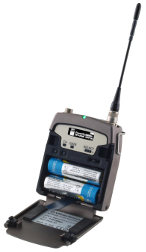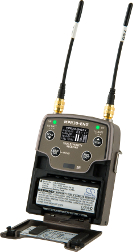Review: Wisycom MTP40S-USX UHF Transmitter & MPR30 ENG Receiver
One of biggest complaints with sound recording is dealing with the cables. Enter wireless technology, usually bringing its own set of interference problems. That, however, is a thing of the past with Wisycom’s MTP40S-USX UHF Wideband Bodypack Transmitter and the MPR30 Wideband ENG Receiver. Attach an omni-directional lavaliere microphone and you can begin capturing great sound.
FEATURES
Comprised of two key components—the MTP40S transmitter and the MPR30ENG receiver—Wisycom has created a small but powerful wireless combo. My review MTP40S transmitter came with a Sanken SAN-11DPTBK1.8 black omni-directional lavaliere microphone. Powered by two AA batteries housed under the front cover, the top has an on/off selector as well as a microphone and antenna connection.

MTP40S
The ENG receiver, also powered by two AA batteries, has an organic liquid crystal display directly above the front cover. Pressing the PWR/EXIT button activates the OLED receiver screen with a battery’s charge, channel use, frequency, and line level. Also on the front are sync, scan, and menu select buttons. The menu button opens a sub menu with headphone level; edit Rx, setting, and infrared. A green LED on the left reminds you that the unit is powered on and a red LED on the left indicates your RF signal. The top features two (A, B) antenna ports, a mini-plug headphone jack, and an AF out jack. The backside on my review unit featured a hotshoe camera mount.
One of the best features of these units is the wide bandwidth (up to 232 MHz) in the 470/952 MHz range. The transmitter is automatically programed using infra red and the outputs are balanced.
The channels are also switchable if you are located in an area with a lot of RF traffic. With 40 groups of 60 channels, that gives the user 2,400 frequencies. Using AA batteries, the user can expect between three and a half to four and a half hours of operation on the receiver and up to 14 hours on the transmitter.
IN USE
I was anxious to receive my Wisycom unit as I had a complicated sound situation where only a hidden, wireless microphone would work. Having reviewed the specifications on line, I knew it should be capable in theory as we would be shooting in an area when our university’s wireless units seldom functioned properly. Without going into all of the technical details of frequency, my main concern was if I was going to get clean audio. The technical data on these microphones is quite impressive, but real world functionality was my main concern.
As promised, the unit fired up with a push of the power button on the receiver and a flip of the toggle switch on the transmitter. Needing to get clean audio in a moving vehicle, the sound person couldn’t sit in the back seat and monitor the sound because it would have been visible on camera. For this particular shoot, the lavaliere microphone was hidden in the car’s passenger side visor and the receiver was 80 feet away in another vehicle. In less than 30 seconds, we were recording clean audio, no interference. Wireless systems usually rely on line of sight. If the transmitter can’t see the receiver, you might have issues. Not only did the transmitter have to send the signal through the glass and metal of the actor’s car, but we also needed to receive it in another vehicle. When I attempted this with another wireless system, too many dropouts made the audio unusable.
The next scene required us to follow the talent from a busy sidewalk, into a brick and steel building, through a maze of drywall corridors, all while the actress was talking and the camera was following her on a stabilizer. Not wanting to get another set of footsteps reverberating off the interior walls, the sound crew remained outdoors leaving only the two actors and camera operator walking inside. The director viewed the LCD monitor via a wireless transmitter in video village and the sound crew was next to him utilizing the Zoom recorder.

MPR30
As the actors walked and talked through the hallways, not once did we lose or experience sound problems created by interference or metal objects in the walls. We did lose our video signal to the monitor multiple times, but the sound was perfect the entire time. I tried to watch the info on the OLED on the receiver to see if it was changing channels or frequencies, however, I had a difficult time seeing it because of the tiny numbers. It didn’t really matter what the unit was doing as long as the set-up continued to work.
SUMMARY
Throughout the shoot, we had no problems with audio because of equipment malfunction. The students, who were assisting on my shoot, asked to use the system on their final projects. That’s a great testimonial for Wisycom.
The only drawback to the system is its price; a bit steep for our university’s budget. If audio is your business, the old adage is true, you get what you pay for. I would give two thumbs up to Wisycom for this wireless system. It never let me down.
Chuck Gloman is an associate professor and chair of the TV/Film Department at DeSales University. He may be reached at chuck.gloman@desales.edu.
Get the TV Tech Newsletter
The professional video industry's #1 source for news, trends and product and tech information. Sign up below.
Chuck Gloman is Associate Professor with the TV/Film Department at DeSales University.

